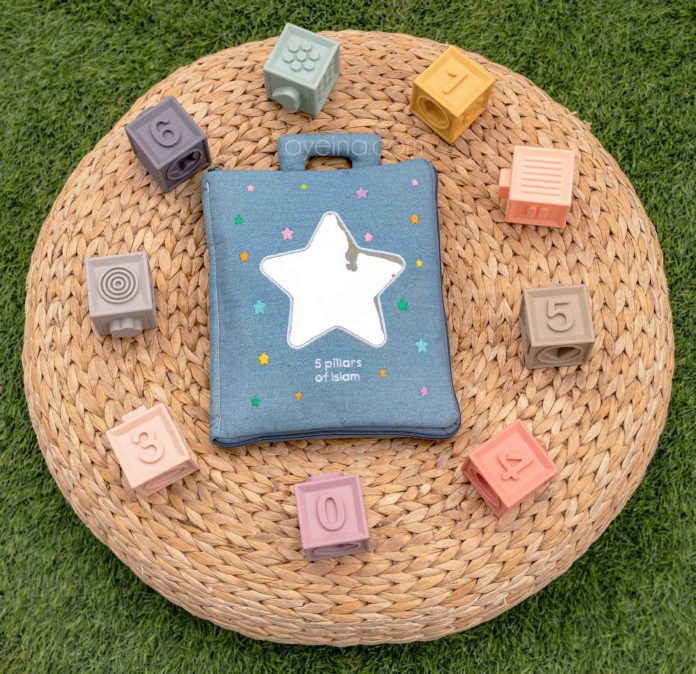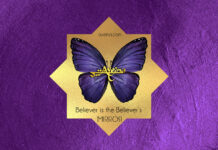BUY HERE (shipping internationally)
0r through retailers around the world (tagged in the caption of THIS post)
Please contact editor@ayeina.com for BULK ORDERS (10 or more on 50% off)
Dive into the world of visual stimulation and tactile sensation through velcro, zip, magnets, buttons, laces, etc. Help your child learn the conditions of shahada, timings and positions of salah, sunnah foods to start or end the fast with, numerical literacy through zakat, and the rites of Hajj. “5 Pillars of Islam” is ideal for helping little ones practice and improve their fine motor skills, hand-eye coordination, and sensory processing through interactive play. Let your child learn through visual stimulation and tactile sensation with the help of velcro, zip, magnet, buttons, etc. Some of the skills your little one will practise include lacing, matching, colour recognition, numeracy, problem-solving, and much, much more. There are 10 interactive pages encouraging fun, hands-on learning of numbers, colours, time, shapes, sizes, fruits, vegetables, and so much more while revolving around the basic concepts of Islam. The book measures 10″ high x 8″ wide. A great Islamic learning tool for any pre-school parent.
See the GUIDES on Instagram for a more in-depth look. Kids will connect to the basic foundation of Islam – its five pillars:
1) SHAHADA – velcro hands with an immovable shahada finger + laced gift pouch for the sunnah book
2) SALAH – rotating sensory clock + moving salah doll
3) ZAKAT – crinkle calculator + magnetic gold and silver coins for zakat jar
4) SAWM – refrigerator with sunnah foods + iftar/suhoor plate
5) HAJJ – steps of Hajj puzzle + Tawaf & Sa’ee

1) Shahada
This page has a hand with turning fingers that can stick to the palm except for the shahada finger (index finger). In Tashahhud, we point with our index finger to testify that Allah is One – which is the core foundation of our deen. Tawheed – ALLAH IS ONE. The creases of the fingers are defined to teach the child about reciting dhikr on our hands as they will testify for us in front of Allah.
The Prophet (ﷺ) commanded them to be regular (in remembering Allah by saying): “Allah is most great”; “Glory be to the King, the Holy”; “there is no god but Allah”; and that they should count them on fingers, for they (the fingers) will be questioned and asked to speak. [Sunan Abi Dawud 1501]
The next page has a gift shown – representing the gift of Sunnah. Allah sent Muhammad ﷺ as a mercy to us all. There are no sacred words (like Allah, Muhammad, etc.) written inside this fabric book to maintain its sanctity (as kids may use the book for rough play). There is a small puffy book inside the gift box that says: “This Sunnah Book belongs to: __________” so it can be customised for each child with their name on the card. The term Sunnah is applied to the Prophet’s ﷺ guidance which is well-established in a general sense in all of his affairs – meaning his path, his methodology, and his way. The book is attached so your child doesn’t lose it. The ribbon of the gift box can be laced into an infinity sign, helping the child with fine motor skills.
2) Salah
The first page of this pillar shows a clock with a rotating disc in the middle that has all 5 prayer names written over it. You can discuss with the child the importance of time in Islam. How each Salah has a specific time for a sense of routine and structure in our lives while keeping Allah as the centre of it all. You can rotate the disc as you talk about the time of Fajr, Dhuhr, Asr, Maghrib, and Isha. You may also talk about how the time of Salah differs across the globe.
The second page of this pillar shows a woman on a prayer mat – which can be used to teach kids various positions of Salah. This video is a great start if you want to know how Muhammad ﷺ prayed and how you can teach your child too through interactive play. The woman is fixed in the middle to keep her secure in one place over the mat while still being able to move her for different positions of Salah. Takbir, Qiyam, Ruku’, I’tidal, Sujood, Tashahhud, Tasleem, and a dua in the end.
3) Zakat
This page teaches the meaning of giving while teaching kids about numbers, colours, addition/subtraction etc.
The first page shows a calculator with a crinkle sound when each number is pressed by a child. The calculator screen shows 2.5% denoting how Zakat requires Muslims to donate 2.5% of their wealth annually to purify their wealth and establish economic stability in the community.
The second page shows a transparent Zakat jar with a zip and an open lid to pass through silver and gold coins. Zakat is due on all forms of gold and silver (whether it is in the form of jewellery or coins etc.). There are 4 magnetic soft metallic coins in total – attached on a magnetic strip so they’re not lost once the child is done playing with them.
4) Sawm
This page shows the Sunnah foods to start or end the fast with. The first page shows a plate with a fork, spoon, and knife while the second page hosts a refrigerator with all the Sunnah foods and drinks (some mentioned in the Quran) inside like dates, honey, Zamzam, vinegar, milk, fig, olives, grapes, bread, watermelon, pomegranate, cucumber, pumpkin soup, meat, and banana.
View this post on Instagram
5) Hajj
This page shows a few of the rites of HAJJ. The first page shows a lift-a-flap puzzle for Hajj steps – from Ihram, Tawaf, Sa’ee, Jamaraat, Mina, Muzdalfah, Arafat, sacrifice, hair-trimming/cutting. While the second page shows Safa and Marwa mountains between which a small muhrim can be moved to and fro. He can also be detactched from the ribbon so he can go around the sensory Ka’bah art for Tawaf practice. A child can be taught to say “labbaik Allahumma labbaik” while making the small muhrim do Umrah. There is also a bead counter on which they can be taught an abacus-like counting of 7 rounds.
View this post on Instagram
5 Pillars of Islam comes with a padded handle which provides portability for quiet and focused time anywhere at home or for keeping little ones quietly entertained as a travel companion. It’s perfect for keeping kids busy while learning on car journeys, plane rides, train journeys, on the bus, at the airport or station, during khutbah at the masjid, at weddings, and in waiting rooms. It fully zips up to close for easy storage of small parts.





